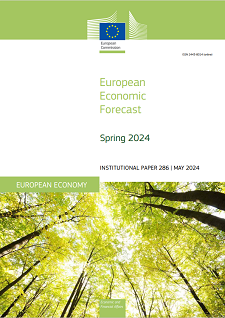DG ECFIN European Economic Forecast (Spring 2024)

date: 03/06/2024
According to DG ECFIN last forecast, almost all EU Member States are expected to return to growth in 2024 with a projected GDP growth at 1.0% in the EU and at 0.8% in the euro area. For 2025, it is forecast to improve to 1.6% in the EU and to 1.4% in the euro area. More generally, economic convergence within the EU is set to progress further with the economic expansion in southern Europe outpacing growth in northern and western Europe, but also with the reduction of the gap with the newer Member States.

Harmonized Index of Consumer Prices (HICP) inflation is projected to continue declining over the forecast horizon. In the EU, it is now expected to decrease from 6.4% in 2023 to 2.7% in 2024 and 2.2% in 2025. In the euro area, it is forecast to fall from 5.4% in 2023 to 2.5% in 2024 and 2.1% in 2025. Core inflation (excluding energy and food) is expected to decline over the forecast horizon at broadly the same pace as headline inflation, remaining just slightly above. Moreover, credit conditions are still expected to improve with an expected decrease of the short-term nominal interest rates from 4% to 3.2% in 2024 and 2.6% in 2025. But investment appetite in Europe is faltering, dragged down by a negative construction cycle.
The EU created more than two million jobs in 2023 and reached, in March, its record low of EU unemployment rate (6.0%). This strong labour market performance reflects favourable developments in both labour demand and labour supply, also due to migration. The EU is still expected to generate another 2.5 million jobs, while the unemployment rate should hover around the current record-low rates. By 2025, average real wages are set to recover their 2021 levels, though this is not the case for all Member States.
After a sizeable reduction in 2022, the EU government deficit in 2023 increased marginally from 3.4% to 3.5% of GDP. The EU government deficit is nevertheless projected to resume declining in 2024 (to 3.0%) and 2025 (to 2.9%). By the end of 2025, in most Member States the debt-to-GDP ratios are projected to be lower than in 2020 but to remain above 60% of GDP in 12 countries.
Regarding its exchange with the world, EU exports of goods and services are expected to expand by 1.4% this year and to attain 3.1% in 2025. The current account balance of the EU is expected to rise back to 3.1% of GDP in both years.
